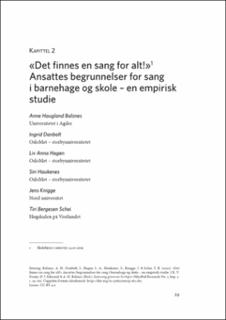| dc.contributor.author | Balsnes, Anne Haugland | |
| dc.contributor.author | Danbolt, Ingrid Anette | |
| dc.contributor.author | Hagen, Liv Anna | |
| dc.contributor.author | Haukenes, Siri | |
| dc.contributor.author | Knigge, Jens | |
| dc.contributor.author | Schei, Tiri Bergesen | |
| dc.date.accessioned | 2022-06-03T12:37:40Z | |
| dc.date.available | 2022-06-03T12:37:40Z | |
| dc.date.created | 2022-05-25T13:27:31Z | |
| dc.date.issued | 2022 | |
| dc.identifier.citation | Balsnes, A. H., Danbolt, I., Hagen, L. A., Haukenes, S., Knigge, J. & Schei, T. B. (2022). «Det finnes en sang for alt!»: Ansattes begrunnelser for sang i barnehage og skole – en empirisk studie. I R. V. Strøm, Ø. J. Eiksund & A. H. Balsnes (Red.), Samsang gjennom livsløpet (s. 29–65). Cappelen Damm Akademisk/NOASP. | en_US |
| dc.identifier.isbn | 9788202716356 | |
| dc.identifier.uri | https://hdl.handle.net/11250/2997539 | |
| dc.description.abstract | This chapter is based on two studies which aim to provide knowledgeabout the position of singing in Norwegian kindergartens and schools: (a) a nationalquantitative cross-sectional survey with kindergarten teachers and primary school/lower secondary school teachers, and (b) case studies in selected kindergartens andschools, where the data collection consisted of participatory observation and interviews with leaders and teachers. The chapter presents an attempt to incorporateboth studies into a triangulation design where different types of data material anddifferent analysis methods (quantitative and qualitative) are combined to investigate the question “why sing?” – that is, how singing is justified in kindergartenand school. Furthermore, we ask if different views on the functions of singing correlate with teachers’ personal characteristics (e.g., educational background, musicalexpertise, age, gender) and with the extent to which teachers sing with their children/students. Theoretical perspectives are grounded in music education philosophy with emphasis on Øivind Varkøy’s (2015) justification categories. The resultsshow that employees in Norwegian kindergartens and schools justify singing withseveral arguments that are placed within and across Varkøy’s categories. We find aclear consensus among the participants in our sample that singing is particularlyrelevant for extra-musical functions (e.g., learning a language, building a community). The least emphasized, however, are arguments connected with curricula andthe development of the singing voice. | en_US |
| dc.language.iso | nob | en_US |
| dc.publisher | Cappelen Damm Akademisk | en_US |
| dc.relation.ispartof | Samsang gjennom livsløpet | |
| dc.rights | Navngivelse 4.0 Internasjonal | * |
| dc.rights.uri | http://creativecommons.org/licenses/by/4.0/deed.no | * |
| dc.title | «Det finnes en sang for alt!» Ansattes begrunnelser for sang i barnehage og skole – en empirisk studie | en_US |
| dc.type | Chapter | en_US |
| dc.type | Peer reviewed | en_US |
| dc.description.version | publishedVersion | en_US |
| dc.rights.holder | © 2022 Anne Haugland Balsnes, Ingrid Danbolt, Liv Anna Hagen, Siri Haukenes, Jens Knigge, Tiri Bergesen Schei | en_US |
| dc.source.pagenumber | 29-65 | en_US |
| dc.identifier.doi | 10.23865/noasp.162.ch2 | |
| dc.identifier.cristin | 2027384 | |
| cristin.ispublished | true | |
| cristin.fulltext | original | |
| cristin.qualitycode | 1 | |

